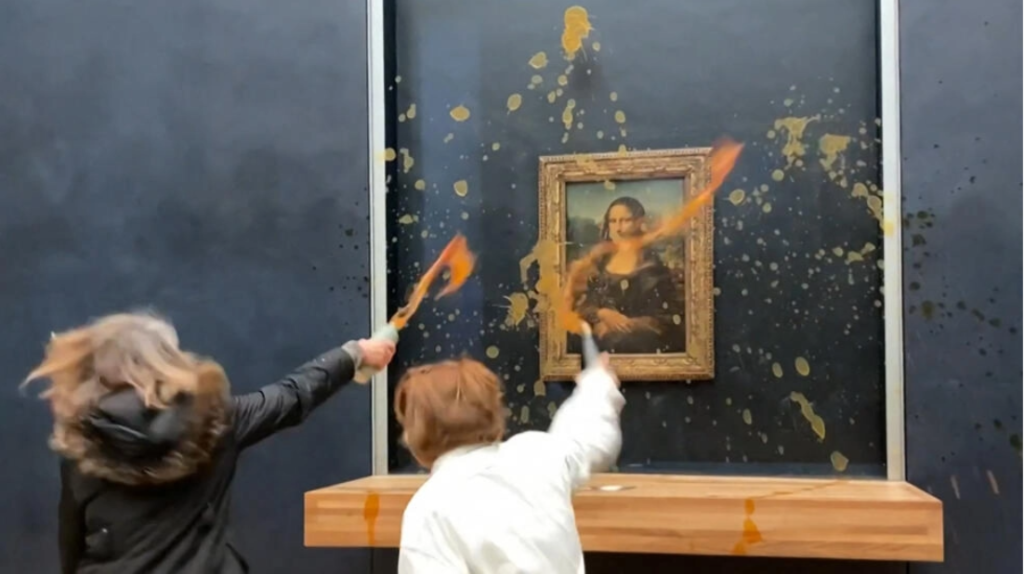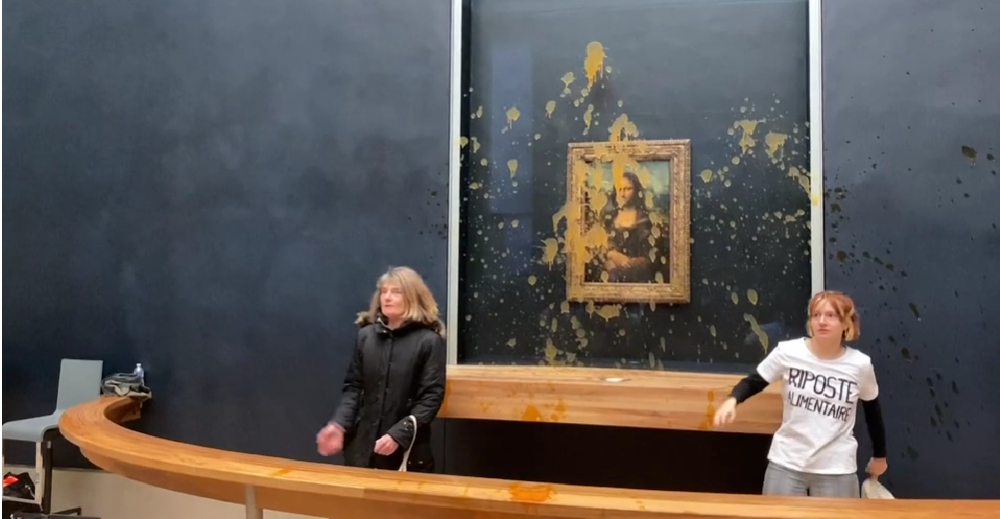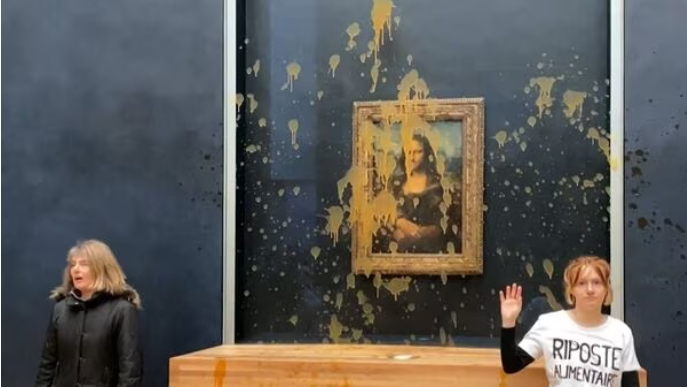Demonstrators in France have tossed soup at the Mona Lisa, which is protected by glass, as they advocate for the right to “healthy and sustainable food.”
The recent incident at the Louvre involving protesters throwing soup at the iconic Mona Lisa, a 16th Century masterpiece by Leonardo da Vinci, has sparked global attention. The demonstration, carried out by a group known as Riposte Alimentaire (Food Counterattack), unfolded as a call for the right to “healthy and sustainable food.” This act of protest, captured on video, showcased two female demonstrators wearing T-shirts emblazoned with the slogan “food counterattack,” who proceeded to throw liquid at the protected painting.
The Mona Lisa, residing in the Louvre in central Paris, is one of the most famous artworks globally, drawing millions of visitors each year. The painting is carefully preserved behind protective glass, and the Louvre administration assured the public that the artwork sustained no damage during the incident.
In the video footage, the protesters, after throwing the liquid, positioned themselves in front of the painting, engaging in a vocal dialogue about the perceived conflict between art and the fundamental right to access healthy and sustainable food. They voiced concerns about the state of the agricultural system, asserting that farmers are facing dire circumstances in their line of work.
ALERTE - Des militantes pour le climat jettent de la soupe sur le tableau de La Joconde au musée du Louvre. @CLPRESSFR pic.twitter.com/Aa7gavRRc4
— CLPRESS / Agence de presse (@CLPRESSFR) January 28, 2024
Security personnel at the museum swiftly intervened, placing black screens in front of the protesters and subsequently evacuating the room. The Louvre, in an official statement, confirmed the use of pumpkin soup in the incident and assured the public that the painting was unharmed. The affected room, Salle des Etats, was temporarily closed for security reasons and later reopened to visitors.
Riposte Alimentaire, the group behind the protest, issued a statement on social media, justifying their actions as part of a broader effort to integrate “food into the general social security system.” According to their perspective, the existing food model perpetuates stigma against the most vulnerable and fails to respect the fundamental right to food. The group proposed the issuance of a monthly food card worth €150 (£128) to citizens, as a means to address these concerns.
The Louvre, in response to the incident, declared its intention to file a complaint against the members of Riposte Alimentaire. The museum characterized the group as an environmental movement, indicating that the protest was not only an attack on a cultural treasure but also an infringement on the sanctity of the museum space.
Rachida Dati, France’s Minister for Culture, strongly condemned the act, asserting that “no cause” could justify targeting the Mona Lisa. Dati emphasized the painting’s significance as part of France’s cultural heritage, belonging not just to the present generation but also to future ones. This condemnation from a high-ranking government official highlights the severity with which the act is viewed by authorities.

Security personnel at the museum swiftly intervened, placing
black screens in front of the protesters and subsequently evacuating the room.
The Louvre, in an official statement, confirmed the use of pumpkin soup in the
incident and assured the public that the painting was unharmed. The affected
room, Salle des Etats, was temporarily closed for security reasons and later
reopened to visitors.
Riposte Alimentaire, the group behind the protest, issued a
statement on social media, justifying their actions as part of a broader effort
to integrate “food into the general social security system.”
According to their perspective, the existing food model perpetuates stigma
against the most vulnerable and fails to respect the fundamental right to food.
The group proposed the issuance of a monthly food card worth €150 (£128) to
citizens, as a means to address these concerns.
The Louvre, in response to the incident, declared its
intention to file a complaint against the members of Riposte Alimentaire. The
museum characterized the group as an environmental movement, indicating that
the protest was not only an attack on a cultural treasure but also an
infringement on the sanctity of the museum space.
Rachida Dati, France’s Minister for Culture, strongly
condemned the act, asserting that “no cause” could justify targeting
the Mona Lisa. Dati emphasized the painting’s significance as part of France’s
cultural heritage, belonging not just to the present generation but also to
future ones. This condemnation from a high-ranking government official
highlights the severity with which the act is viewed by authorities.

The context in which this incident occurred adds an additional layer to the narrative. The French capital, Paris, has witnessed protests by farmers in recent days, demanding relief from rising fuel costs and simplified regulations. On the day of the soup-throwing incident, farmers had blocked key roads in and out of Paris, underscoring a broader atmosphere of social unrest.
This incident is not the first time the Mona Lisa has been the target of protest. In 2022, an activist threw cake at the painting, using the act as a symbol to urge people to “think of the Earth.” These instances of targeting a cultural symbol for environmental or social causes reflect a trend of using high-profile artworks to draw attention to broader issues.
The protection of the Mona Lisa has been a priority for the Louvre for decades. Since the early 1950s, the painting has been shielded by safety glass, a measure implemented after a visitor damaged it with acid. In 2019, the museum took additional precautions, installing a more transparent form of bulletproof glass to enhance the painting’s security. The commitment to safeguarding this cultural treasure is evident, given its historical significance and the potential impact of any harm on the global artistic and cultural community.
The history of the Mona Lisa includes a notorious theft in 1911 when Vincenzo Peruggia, an employee of the Louvre, concealed overnight in the museum to steal the artwork. The painting was recovered two years later when Peruggia attempted to sell it to an antiques dealer in Florence, Italy. This historical context adds to the mystique surrounding the Mona Lisa and underscores the value placed on its preservation.
In conclusion, the soup-throwing incident at the Louvre involving the Mona Lisa has prompted reactions from various quarters. The protest by Riposte Alimentaire, while drawing attention to concerns about the agricultural system and the right to healthy food, has been met with strong condemnation from cultural authorities and government officials. The incident underscores the delicate balance between artistic expression, social activism, and the preservation of cultural heritage. As the Louvre considers legal action, this episode will likely become a part of the Mona Lisa’s storied history, contributing to the ongoing dialogue about the intersection of art, activism, and societal issues.



